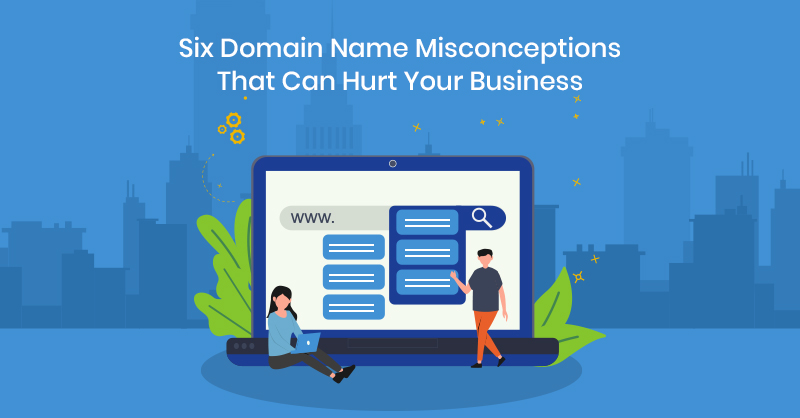Starting, owning, or rebranding an online business all contain their own unique challenges. In today’s digital environment, domain names are intertwined with many facets of these endeavors - which is why choosing domain names can be difficult as well. Generating brand name ideas, considering marketing applications, evaluating long term viability, and considering audience perception can all be important components when registering a domain.
Unfortunately for business owners, domain names themselves have many common misconceptions that make establishing or building an online presence needlessly more complex. In this article, I’ll be going over common domain misconceptions so you can be more informed about how domain names and top-level domains (TLDs, the extension at the end of a domain name) relate with your brand.
Misconception #1: Newer TLDs have a negative effect on your website’s authority
It’s no secret that .COM dominates the online playing field, and should be no surprise that approximately 43% of websites online use it. With this popularity, a new issue has become apparent: as more businesses and individuals acquire .COM domains, less .COM domains are available to register. This issue has resulted in a rising intrigue of alternative domain extensions. With almost 1500 total top-level domains now available, there are many great options for brands - though some businesses are apprehensive to take the leap.

Top 10 Largest TLDs in Sept 2021
Newer generic TLDs (not to be confused with country-specific TLDs like .UK, .DE etc.) have received a bad rap over the years, being touted as detrimental to a sites’ SEO. Specifically, website authority and page rankings are commonly mentioned due to the misconception that search engines don’t prioritize them the same as the popular extensions (like .COM, .NET, and .ORG). If your business is considering an alternative TLD but you have this concern, you’re in luck.
When asked how gTLDs affect search placements, Google said the following: “Our systems treat new gTLDs like other gTLDs (like .com and .org).”
Domain extensions are not evaluated when Google crawls and assesses a site, which means your .NINJA or .MAKEUP site can live on without fear of SEO ranking penalties.
In fact, many businesses and entrepreneurs are utilizing alternative TLDs - whether it be for advertising purposes, identifying their brand within a niche, preventing others from registering their name, or even creating their own TLD. Some great examples would include:
- abc.xyz - Google’s parent company, Alphabet
- github.blog - The software coding management site uses .blog for their blog website
- global.canon - Corporate presence of Canon technology
So, while .COM does represent a large portion of all domain registrations, other TLDs options have continued to grow year over year. If you’re not afraid to step outside the box, it’s best not to discount them!
Misconception #2: If your desired domain name is taken, you need to start from scratch
Coming up with a great brand name as a business or entrepreneur can be a challenge, but struggling to generate a domain name can be just as difficult. If your desired domain isn’t available, starting the domain search from ground zero seems like the logical next step. Fortunately, there are some other avenues you can pursue.
Spend time going through the following when checking a taken domain name’s availability.
1) Visit the domain name’s URL
By visiting the domain you’ll get an indication on the possibility of acquiring the domain through alternative methods. If you see a parked domain, there might still be an opportunity to contact the owner to see if they’re willing to negotiate. Keep an eye out for any contact information on the parked domain. If you see the website is being used by an established brand, unfortunately the chances of acquisition shoot down.

Example of a Parked Domain
2) Check the domain through a Whois Lookup
A whois search tool can provide some key details about your domain of interest. When searching, keep your eyes out for the following:
- Personal Contact Information: This will be the most valuable information, IF that information is available. With the contact info, you can connect with the domain owner and inquire about acquisition. Most domains have domain privacy, which will hide this personal information.
- Registrar & Expiration information: If the domain looks inactive, keep an eye on the domain registrar name and expiration. Domains that expire can end up on expired domain auctions at that registrar or, eventually, it may end up available through public registration.
[caption id="attachment_64350" align="aligncenter" width="654"]
 Example of a Whois Lookup [/caption]
Example of a Whois Lookup [/caption]
(Highlighting domain expiration and email contact)
If contacting the current owner isn’t an option, you could consider using a different domain extension that fits your brand. Another alternative is to use an online domain name suggestion tool to help the brainstorming process.
If you’re able to acquire a domain that’s previously registered and used, it can be very advantageous. Established domain names carry their SEO authority, so if you manage to acquire a previously in-use domain within your brand’s niche, you may have a boost in your site’s search rankings that can provide momentum for driving organic traffic. This is why domain marketplaces and expired domain auctions have become popular over the years.
Misconception #3: Your selected domain name is incredibly important
While certain domains will assist your business, the domain name you choose is not incredibly important. Before you ready your pitchforks, hear me out.
The domain name you select will ultimately represent your brand, yes. But the true value of any domain is accumulated over time. When you register a name that has never had a previous website hosted on it, that domain doesn’t hold much of any value. As you establish your presence, you provide value to that domain name. Creating content, drawing in visitors, building organic backlinks, and establishing your brand name will all result in a valuable domain/website.
With these pieces in place, your site will build domain authority - regardless of whether it is brand.com or thisismybrandnameonline.xyz. This authority can be generated on ANY domain. The domain name is just a tool.
With that said, there are some best practices that help build momentum when establishing domain authority. These same factors apply to naming your business or brand and can contribute to helping your website get traction. Try to keep these in mind when registering a business domain.
- Memorability: Ensure your domain can easily stand out in the mind of your audience. This makes all the difference on receiving repeat visitors.
- Length: Ideally, your domain (and brand) should be concise and short to make it easier for your audience to find and type.
- Brandability: Consider how your domain name will be perceived. Since the domain will likely represent your presence online, it’s important to make sure your name is easily marketable.
Misconception #4: Only one domain per business is required
Domain names are multi-purposed. Beyond hosting your businesses website, they can serve multiple roles, many of which are overlooked. Because of this, owning only one domain name for your business is not only a domain misconception but is a missed opportunity - especially as your business grows.
Here are some of great reasons to consider multiple domains for your business:
-
Lost traffic potential
Your audience or potential new visitors will occasionally spell your domain wrong and may not give it another go. Registering domains that cover common typos and redirecting them to your main site could fix a lost opportunity.
2. Bad players or competitors taking advantage
Lookalike or similar domain names to your primary domain can be used by competitors to drive traffic or by malicious entities to trick your audience. Registering some of them can help your audience have a positive experience.
3. Brand opportunities
As businesses grow, the opportunities to expand their online presence increases. New products, website content, or marketing strategies can all utilize domain names separate from the primary domain.
4. Descriptive branding
Many brands use names that don’t indicate their industry, product, or service. If you’re a small business, including a descriptive word into your domain may help draw users. This could include a service or location.
5. Localization
Incorporating localization into alternative domains is very common. If your business is found across multiple countries, it may be worth registering your brand in other countries' TLDs to connect with your audiences in those countries, or even including the location in the domain name itself.

Fake Examples of Using Multiple Domains
Beyond these reasons, there are plenty of examples of major brands incorporating this strategy into their online presence.
Amazon
Owns many variations of their brand name, along with many country-related domains. They also have separate corporate websites.
Examples:
- Amazn.com
- Amazon.ca
- Amazon.us
- Aboutamazon.eu
- Primevideo.com
GettysImage
GettysImage owns multiple brands in their stockphoto brand suite. Each of them have their own unique domain and website, which can be seen as separate products/services.
Examples:
- GettyImages.com
- FreeImages.com
- iStockPhoto.com
- ThinkStockPhotos.com
NeilPatel
Entrepreneur and well-known marketer NeilPatel has multiple brands he manages with unique domains, all of which are utilized by different parts of his business.
- NeilPatel.com
- Ubersuggest.com
- Quicksprout.com
- Crazyegg.com
Misconception #5: Registering a domain is complete domain ownership
One of the most common domain misconceptions revolves around domain ownership. It’s a topic that is easy to overlook but helpful to understand as a business. When you register a domain, you are technically the owner of the domain name, but you do not have complete ownership of that domain. This is due to the connection between the registrant, registrar, and the registry.
These three entities work together and are tied when it comes to the logistics of registering and managing domains. I’ll break it down.
The registrant is the user who is going to register a domain name (most likely, you). In order to register a domain, the registrant must go through a domain registrar, which is a business that allows users to register domains. Finally, we have the registry. They are the entities that own specific top-level domains. For example, .COM is owned by a company called Verisign, and .XYZ is owned by CentralNic.
So, how does this all work together? Well, when you register a domain, it’s really the registrar registering a domain on your behalf and connecting with the registry/providing them with the registrant's information. The registry is then responsible for managing the database of all domains registered under its TLDs. While registered, your information is assigned to that domain.
At the end of the day, the information assigned to that domain is temporarily in the registries database, which changes when the domain expires. Technically, the domain access is lent to the registrant for however long they maintain registration.
This doesn’t change much for the registrant, but be aware that you can lose your domain through expiration, which can be a stressful experience that can be detrimental to a business. It’s important to monitor your domains to prevent this, so below are some best practices to help.
- Set up auto renewal to automatically renew your important domains
- Register domains in multi-year increments to prevent forgetting
- Have notifications turned on in your registrar to avoid missing an expiration notice
- Select the right credible registrar to help manage your domain names
Misconception #6: Never change or rebrand to a new domain name
Changing or rebranding to a new domain is a difficult process that requires planning and forethought; but it is a misconception that moving domains should be avoided altogether. Beyond domain reasons, rebranding can provide huge long-term advantages depending on your situation, including revitalizing an entire business. With that said, there are reasons that this misconception exists; changing domain names can be challenging and detrimental if not executed correctly.
Here are some important domain-specific best practices you’ll want to keep in mind when changing domains:
-
Avoid massive website overhauls
It can be tempting to make drastic changes to your site when rebranding. Try to minimize complete restructures when changing domains. Not only can it confuse your existing audience, and it will likely cause issues when trying to maintain your search engine rankings.
2. Redirect, redirect and redirect
Easily one of the most important processes involved in a digital rebrand or when changing domains. Setting up 301 redirects from all your old website content to your new content is extremely important not only for previous users getting to their desired content, but also for reassigning link authority to your website. Put together a redirect strategy and ensure no pages are missed!
3. Keep URL structures consistent
Try to maintain a similar URL structure to your previous domain’s website. Search engines can remember crawl paths, so redirects combined with a similar URL structure can help familiarize indexing bots.
4. Maintain content
Restructuring website content through a rebrand will happen, though removing large portions of content or changing much of it all at once can have a detrimental effect on how your site’s perceived, especially by search engines. Try to keep much of your content consistent, especially content-dense areas such as blogs or informational resources.
Conclusion
After going through each of the various domain misconceptions, it should be clear that there are nuances and strategies when it comes to what domains you register, how you acquire them, and how you use them. Each of the misconceptions mentioned present unique decisions which create new business opportunities, whether it be registering new TLDs, acquiring domains through non-traditional methods, using multiple domain names, or domain best practices when rebranding.
Much like other areas in business ownership and management, it’s easy to make quick decisions regarding domains. Instead, invest the time to properly assess decision points and keep in mind the various beneficial use cases that domain names can provide. At the end of the day, it may help further define your brand and benefit your online presence in the long run.






